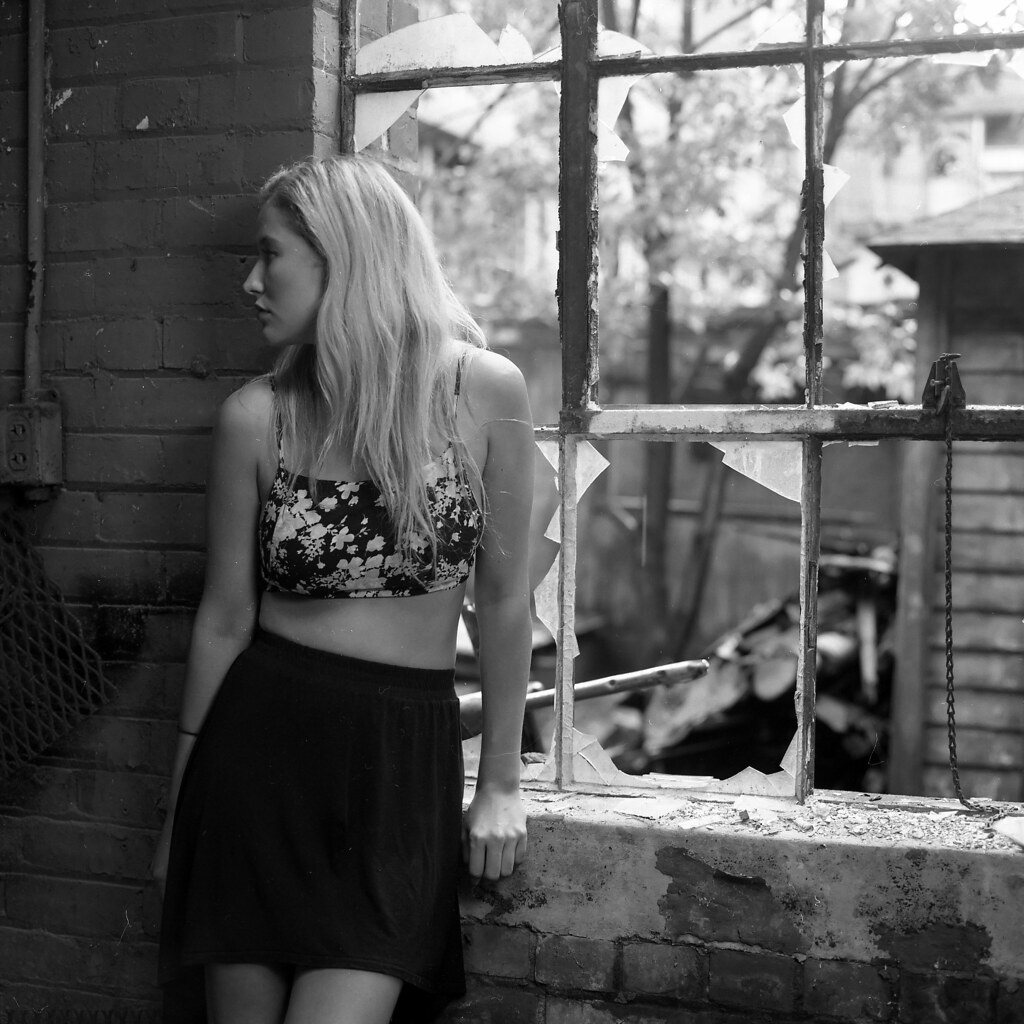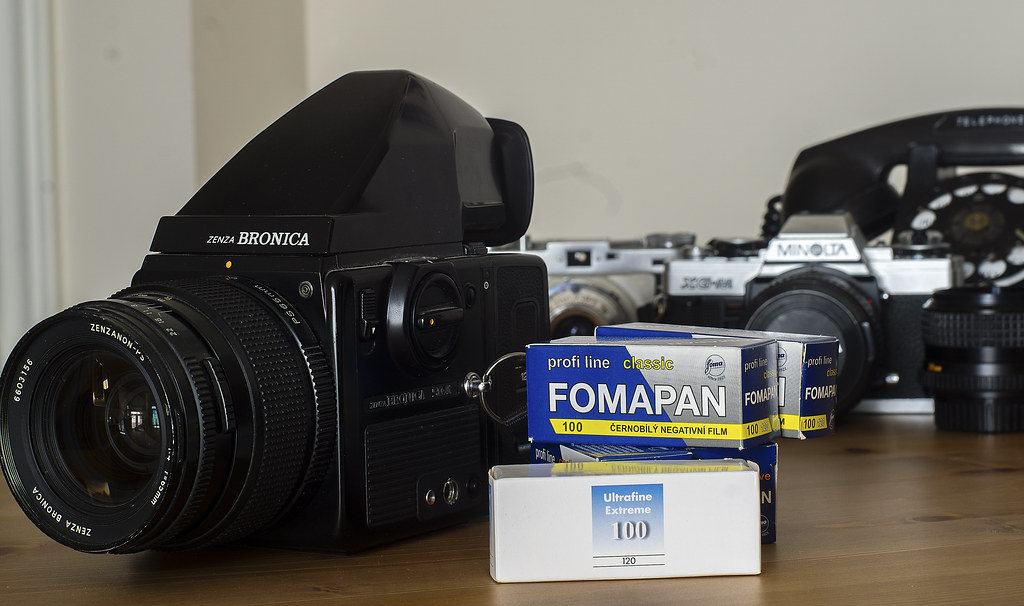I can trace my love and hate of medium format 6×6 SLRs from my time working with the Bronica SQ system. I had a pair of them at one time, the first being the SQ-Am, which was a bear to work with and chewed through batteries like no one’s business and then the battery died. Since I had a bunch of lenses already, I grabbed the much nicer SQ-Ai, but it lacked a waist-level finder and an action grip, making the camera troublesome to use. Plus, it had a tendency to spew the batteries out. Eventually, I gave the camera away to a fellow photographer, who, in turn, loaned it back to me to write this review, so thanks to Mike Bitaxi for loaning the thing back for this review.
Camera Specifications
Manufacturer: Bronica Co., Ltd
Model: SQ-Ai
Type: Single Lens Reflex
Format: Multiformat (Back Dependent) [120/220, 135 (35mm), Polaroid Type-100]
Lens: Interchangeable, Bronica SQ-Mount
Shutter: Electronic Seiko #0 Leaf Shutter, 16s – 1/500s + Bulb
Dimensions (WxHxD): 92x109x179mm (with 80mm lens, SQ-i back, and waist-level finder)
Weight: 1,515g (with 80mm lens, SQ-i back, and waist-level finder)
Power Source: 4x LR44 batteries
Year of Manufacture: 1990-2003
Background
Zenzaburō Yoshino, the third son of a notable rice merchant, loved well-made cameras. He was attracted to the precision construction of cameras from Rollei, Leitz, and Zeiss Ikon and dreamed of building such a camera in Japan. Not settling to let that dream stay a dream, he opened a camera shop in Tokyo that specialised in selling German cameras, which proved popular among the Americans who were part of Japan’s occupation after World War Two. He also opened Shinkodo Works, which produced art deco-styled accessories like cigarette cases under the Zenza Bronica brand and sold in department stores. Taking some money from his family and combining it with the profits from Shinkodo and his camera shop, he directed Shinkodo to develop a precision SLR that used medium format film and was also a system camera. The prototype of the Yoshinoflex arrived in 1956; it would take eight more prototypes before Yoshino was happy with the camera. He took the camera to the Philadelphia Camera Show in 1958 to show off the Zena Bronica. The camera is a 6×6 focal plane shutter camera with interchangeable lenses made by Nikon with an integral focusing helical, various viewfinders, and removable backs. The camera followed some of the same design cues as the Hasselblad 1000F and 1600F cameras. But unlike the Hasselblad, the Bronica featured an instant return mirror. The camera proved successful and began to sell under the name the Bronica Z; there were some moderate updates with the Bronica D. The first significant update came in 1961 with the Bronica S; while it used the same lenses as the earlier models, the new bodies required new viewfinders and film backs. It also removed slow shutter speeds and the top speed of 1/1250″. It also removed the ability to do multiple exposures on the same frame. The S2 added the ability to remove the internal focusing helical to allow longer lenses to be produced with the focusing helical on the lens barrel. The S2A fixed some internal issues, causing the camera to jam when advancing the film. The following biggest change came in 1972 with the Broncia EC. The EC or Electric Camera added electronics to the camera, especially the shutter release; again, it could use all the same lenses as the S-Series but required new viewfinders and film backs. One such finder added TTL meterings, and in 1975, the Bronica EC-TL added a meter into the camera body with a new finder that allowed for semi-automatic exposure metering. During this time, Zenza Bronica split with Nikon for the production of lenses, switching first to Zeiss Jena lenses before opening in-house lens production. In 1976, Bronica released their first 6×4.5 camera, the ETR, which used a leaf shutter mounted in the lens and started experimenting with a new body style. This new body style would show up in 1980 with the new Bronca SQ; taking everything from the past, this new ‘all-black’ design style featured all new lenses with an electronic leaf-shutter made by Seiko and mounted in the lens, including new finders and film backs. An AE finder and mirror-lockup came in 1982 with the SQ-A; in 1983, the SQ-Am added an integral motor drive. However, the biggest change came in 1990 with the SQ-Ai. The SQ-Ai had a motor drive, but it was a separate accessory; it also updated the film backs for better communication with AE finders. In 1998, Zenza Bronica was purchased by Tamron, who wanted the lens production facilities but continued producing cameras until at least 2003, when all camera production ceased.




Impressions
Don’t get me wrong, the SQ-Ai is a handsome, fine-looking camera. the ETRS is a better-looking camera with the prism finder, but the SQ-Ai still looks sharp. Now, I can only go on my experience with an SQ-Ai using the AE finder, which is a big honking thing. The overall style of the camera screams the 1980s/1990s. My later review of the Contax 645 AF shows the progression from that late 80s and early 90s to late 90s/2000 look and feel. The camera’s plastic construction certainly helps with the weight. Overall, it is well laid out, with lots of feedback, with the controls from the mirror slap and the clear click from the leaf shutter. The shutter speed controller is nice and works well even with gloved hands. There’s plenty of information in the AE finder, and the finder is big and bright. There’s nothing left to chance or guesswork. The biggest downfall is that the camera cheaps out on some heavy-use controls, namely the battery compartment; the simple plastic tab loses strength and, in my case, fails. But with a bit of tape, you can keep your batteries in, and the use of a holder is one more point of loss.





Experience
If you have never used a medium format SLR system camera before the Bronica SQ makes it much easier and less-expensive to get into than something like the Hasselblad. The camera itself is light and doesn’t take up too much space. Loading the film backs is straightforward and everything about the camera just works. The SQ-Ai has some added features that allow for metering, semi-automatic operation and offers up excellent optical quality. But the biggest problem I faced with the SQ-Ai is how the camera came to me, it wasn’t exactly designed for ease-of-use. The SQ-Ai is a system camera, so you can customise the configuration as you see fit, I had the AE finder, but no action grip or motor drive, so I had to hold it by the bottom and then up to my eye. Having previously used a Kiev 88 with a waist-level finder that proved much easier to operate. Sadly I could not at that time find a SQ waist level finder or the action grip anywhere for a reasonable price. The second issue I had with the camera is that it constantly was spitting the batteries out the bottom, probably because the battery door was a bit damaged, so the latch didn’t hold shut. And with the battery door on the bottom, well you see the problem. The worst part was that the four LR44 batteries are housed in a holder, so when the thing drops out, not only do you have to find four tiny batteries but hope you don’t loose the holder. The first time this happened was in the winter, I lost the four batteries but found the holder at least. Alright so aside from these two glaring issues, the SQ-Ai offers up a similar experience to any other medium format SLR, think Hasselblad, the focusing screen is big and bright and easy to focus with a microprism, and with a prism finder it offers up a similar feel to a 35mm SLR but without an action grip or motor drive (I recommend the grip) it can be awkward to use. What also is great is that the film backs are hot-swappable, meaning you have to slid in a dark slide but can easily switch between different film types, and you can set the ASA and it will integrate with the metering system in the appropriate finder. And when it came to metering it was accurate until the meter died.




Optics
The lenses available for the Bronica system are all excellent and well-made optics. Mainly because the design and construction came from two excellent sources, first Nikon and second Zeiss Jena, all combining both German and Japanese construction and quality. During my time with the Bronica SQ-System, I used three lenses, which make up an excellent three-lens kit for any SQ. The first is the wide-angle 65mm f/4; while not as wide as I like today, it offered up a good angle of view for architecture and landscape work without being too wide. But if 65mm isn’t wide enough, Bronica offers 50mm, 40mm and 35mm (fish-eye). The second lens in my kit was the 80mm f/2.8, the ‘normal’ lens, which made for a great compact carry-around lens. The third and final lens is the 150mm f/4, perfect when you need a bit more reach and made for a killer portrait lens. Of course, Bronica produced lenses in 180, 200, 250, and 500mm options, as well as 110mm Macro and three zoom lenses, 50-100, 75-150, and 140-280mm. You’re also going to notice that there are two versions of almost every lens, Zenzanon-S and Zenzanon-PS; the difference is that the PS lenses have a slightly better coating on them, so if you’re working with colour film and worry about off-axis light flare, then look at getting the PS style lenses. In all cases, you’ll get excellent optics that still have a following today among the users of the Bronica kit; it’s easy to see why Tamron wanted to get their hands on the Bronica lens manufacturing base.




The Lowdown
Look, there’s nothing wrong with the SQ series; they are well-made of cameras that are, with all considerations, relatively modern and embrace modern technology more than Hasselblad, which remained staunchly mechanical and manual. The only thing with Bronicas is that you have to build the system how you want it; if you like that prism finder, get the grip; if you prefer no grip, get that waist-level finder. These are great modern cameras with their quirks, but if you can adapt, go for it. The strongest argument for the cameras is their lenses; it was perhaps the only bright point of my time with the system. Would I get another one? I have my Mamiya m645, and it does what I need it to. I have a lot more invested there, and I don’t have the space for another system. The most significant barrier to these cameras is the cost; you can find plenty on the used market in ready-to-go state, so a lens, back, finder and body, but you’re going to pay between 1500 to 2000 more if there are extras. If you are looking, go with either the SQ-A or SQ-Ai; avoid the SQ-Am and the SQ-B (which is a stripped-down version of the SQ-A). But certainly invest in some lenses, which will always be a little extra. These aren’t bad cameras, and if you are looking for something that offers a near-Hasselblad experience without Hasselblad prices, the SQ-Ai is a good choice.




Further Reading
Don’t just take my word on the SQ-Ai; you can check out the reviews by other awesome camera reviewers!
Emulsive – Camera Review: Bronica SQ-Ai
Joshua Timpko’s Film Photography Journey – Camera Review: Bronica SQ-Ai
Chris Orange – Zenza Bronica SQ-Ai – Perfect for Landscapes
Aows – Bronica SQ-Ai: Overview & Thoughts
